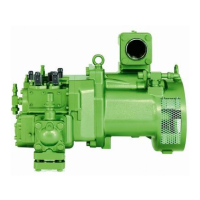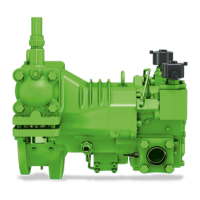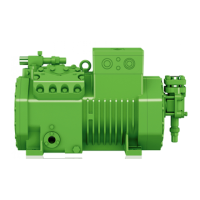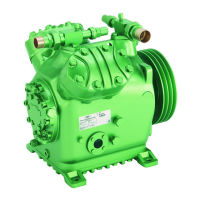18 ESB-130-3 RUS
ST-130-2
2
2 Functions
The OLC-D1-S can monitor either the
minimum or the maximum oil level,
depending on its mounting position
and incorporation into the safety
chain. If the minimum and the maxi-
mum oil level should be monitored,
two OLC-D1-S devices must be
installed.
2.1 Monitoring of the minimum
level
Lock out
The compressor is shut off, if the
prism sticks out of the oil longer than
the delay time specified by the circuit.
The OLC-D1-S then opens the output
contact and the circuit locks out elec-
tronically: The control voltage to the
compressor contactor is interrupted.
The red LED at the face side of the
opto-electronic unit lights up (figure 1)
as well as the signal lamp H4.
Reset
The circuit can be manually reset by
pressing the reset button. This reset
button (S4) has to be mounted into
the swich board. (Connection see
sche matic wiring diagram.)
2 Fonctionnement
Le OLC-D1-S peut contrôler soit le
niveau d'huile minimal soit le niveau
d'huile maximal, dépendant de la position
de montage et de l'intégration dans la
chaîne de sécurité. Pour surveiller le
niveau d'huile minimal et maximal en
même temps, deux OLC-D1-S doivent
être installés.
2.1 Contrôle du niveau d'huile minimal
Verrouiller
Le compresseur est arrêté des lors que le
temps pendant lequel le cône de verre
dépasse le niveau d'huile est supérieur à
la la temporisation prédéfinie par le
réglage.
Le OLC-D1-S ouvre alors le contact de
sortie et le circuit se verrouille électroni-
quement: la tension de commande du
con tacteur du compresseur est alors
coupée. La LED rouge sur le côté frontal
de l'unité opto-électronique s'allume (figu-
re 1) et ainsi que la lampe H4.
Déverrouiller
Le circuit peut être remis manuellement
en fonctionnement par la touche de reset.
Cette touche (S4) devra être montée
dans l'armoire électrique. (Raccordement
voir schéma de principe.)
2 Funktionen
Das OLC-D1-S kann entweder das
mini male oder das maximale Ölnive au
über wachen, je nach Montage-Posi ti -
on und Einbettung in die Sicher heits -
kette. Falls sowohl das mini male wie
das maximale Ölnive au über wacht
werden soll, müssen zwei OLC-D1-S
installiert werden.
2.1 Minimale Ölniveau-Überwa-
chung
Verriegeln
Der Verdichter wird abgeschaltet,
wenn der Glas-Kegel länger als die
durch die Schaltung vorgegebene Ver -
zöge rungs zeit aus dem Öl herausragt.
Das OLC-D1-S öffnet dann den Aus -
gangs kon takt und die Schaltung ver-
riegelt elektronisch: Die Steuerspan -
nung zum Verdich ter schütz wird unter-
brochen. Die rote LED auf der Stirn -
seite der opto-elektronischen Ein heit
(Abb. 1) und die Signallampe H4
leuchten.
Entriegeln
Die Schaltung kann über eine Reset-
Taste manuell zurück gesetzt werden.
Diese Reset-Taste (S4) muss im
Schalt schrank montiert werden.
(Anschluss siehe Prinzipschaltbild.)
Abb. 1 Abmessungen und Aufbau Fig. 1 Dimensions and design
Fig. 1 Dimensions et construction
1 Prisma-Einheit
2 Glas-Kegel
3 Dichtung
4 Opto-elektronische Einheit "OLC-D1"
(360° drehbar)
5 Anschlusskabel
6 Schraubkappe
1 Prism unit
2 Glass cone
3 Gasket
4 Opto-electronic unit "OLC-D1"
(360° revolving)
5 Connecting cable
6 Screwing cap
1 Unité prisme
2 Cône en verre
3 Joint
4 Composant opto-électronique "OLC-D1"
(mobile sur 360°)
5 Câble de raccordement
6 Chapeau à visser
5.4 Kältemitteleinfülle
• BevorKältemitteleingefülltwird:
- Verdichter nicht einschalten!
- Ölsumpfheizung einschalten
- Ölstand im Verdichter kontrollieren
(im Schauglas-Bereich)
• FlüssigesKältemitteldirektinden
Verflüssiger bzw. Sammler füllen,
bei Systemen mit überflutetem
Verdampfer evtl. auch in den Ver-
dampfer.
• VordemStartdieAnlagesoweit
vorbefüllen, dass der Betrieb
innerhalb der Einsatzgrenzen
möglich ist.
• WährenddesBefüllvorgangsist
ein kurzzeitiger Betrieb unter
2,4 bar (g) möglich, wobei die
Verflüssigungstemperatur entspre-
chend niedrig gehalten werden
muss. Die Zeitverzögerung des
Niederdruckschalters darf dabei
nur einmalig aktiviert werden.
• NachInbetriebnahmekannes
notwendig werden, Kältemittel zu
ergänzen:
Bei laufendem Verdichter Kälte-
mittel auf der Saugseite einfüllen,
am besten am Verdampfer-Eintritt.
• GemischemüssendemFüllzylinder
als blasenfreie Flüssigkeit ent-
nommen werden.
Bei Flüssigkeits-Einspeisung:
Achtung!
Gefahr von Nassbetrieb!
Äußerst fein dosieren!
Druckgas-Temperatur mindes-
tens 30 K über Verflüssigungs-
temperatur halten.
Gefahr!
Berstgefahr von Komponenten
und Rohrleitungen durch hydrau-
lischen Überdruck.
Überfüllung des Systems mit Käl-
temittel unbedingt vermeiden!
Achtung!
Kältemittelmangel bewirkt
niedrigen Saugdruck und hohe
Überhitzung (Einsatzgrenzen
beachten!).
5.4 Chargingrefrigerant
• Beforerefrigerantischarged:
- Do not switch on the compressor!
- Energize the crankcase heater
- Check the compressor oil level
(within sight glass range)
• Chargeliquidrefrigerantdirectly
into the condenser resp. receiver.
For systems with flooded evapora-
tor refrigerant can be also charged
into the evaporator.
• Beforestarting,thesystemmustbe
pre-charged so far that operation
within the application limits is
possible.
• Duringtherefrigerantcharge
process, a temporary operation
under 2.4 bar (g) is possible.
Keep the condensing temperature
accordingly low. Thereby the time
delay of the low pressure switch
may only be activated once.
• Aftercommissioningitmaybe
necessary to add refrigerant:
Charge the refrigerant from the
suction side while the compressor
is in operation. Charge preferably at
the evaporator inlet.
• Blendsmustbetakenfromthe
charging cylinder as “solid liquid”.
If liquid is charged:
Attention!
Danger of wet operation!
Charge small amounts at a time!
Keep the discharge temperature
at least 30 K above condensing
temperature.
Danger!
Explosion risk of components
and pipelines by hydraulic
overpressure.
Avoid absolutely overcharging of
the system with refrigerant!
Attention!
Insufficient refrigerant causes
low suction pressure and high
superheating (observe operating
limits!).
5.4 Заправка хладагентом
• Перед заправкой хладагента:
- Не включайте компрессор!
- Включить подогреватель картера.
- Проверьте уровень масла в компрес-
соре (в пределах смотрового стекла)
• Заправляйте жидкий хладагент
непосредственно в конденсатор или
ресивер. Для систем с затопленным
испарителем, возможна также
заправка в испаритель.
• Перед запуском, система должна быть
пред-заправлена для обеспечения
работы в пределах области
применения.
• Во время заправки хладагента,
допускается временная работа при
давл. ниже 2,4 bar (g). Держите
соответственно низкую температуру
конденсации. При этом задержка
времени для реле низкого давления
может быть активирована только
один раз.
• После ввода в эксплуатацию может
потребоваться дополнительная
заправка хладагента:
Заправляйте хладагент со стороны
всасывания во время работы
компрессора. Предпочтительно
заправлять на входе в испаритель.
• Смеси из заправочного цилиндра
должны быть взяты в виде свободной
от пузырьков жидкости.
При заправке жидкого хладагента:
Внимание!
Опасность влажного хода!
Заправляйте небольшое количество
за один раз!
Температура нагнетания должна
быть как минимум на 30 К выше
температуры конденсации.
Опасность!
Опасность разрыва компонентов и
трубопроводов из-за избыточного
гидравлического давления.
Избыточная заправка хладагентом
абсолютно недопустима.
Внимание!
Недостаточное количество
хладагента обуславливает
низкое давление всасывания и
повышенный перегрев
(соблюдайте эксплуатационные
ограничения!).
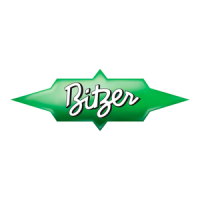
